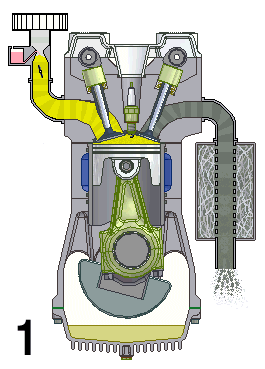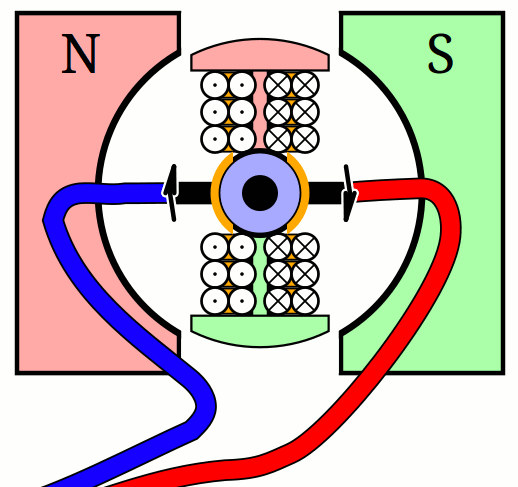Internal combustion engine vs electric motor
Electric motors already occupy a important place in our everyday lives. They are found in many everyday items such as electric toothbrushes, washing machines, and coffee machines. Electric cars, in particular, are bringing electric motors even more into focus. They also have to compete with conventional internal combustion engines.
But what are the differences between these two types of drive? We got to the bottom of this question and provide you with the answers in this article.
Internal combustion engine
An internal combustion engine consists of the following components: Combustion chamber, intake and exhaust valves, piston, connecting rod, crankshaft and, if applicable, a spark plug. Four steps must be performed in order in order to make a car drive.

1. Priming: The piston moves downwards in the combustion chamber and draws an air–petrol mixture (in the case of diesel, only air) through the intake valve into the combustion chamber.
2. Compression: The piston moves upwards and thus compresses the mixture or air that has flowed in. The inlet and outlet valves are closed so that nothing can escape.
3. Operation: If the pressure is high enough, the spark plug produces a spark, and the mixture explodes. In the case of diesel vehicles, the fuel is injected into the combustion chamber, where it self-ignites because of the high pressure and temperature. The explosion pushes the piston down – the engine is in operation.
4. Emission: The piston moves up again, the exhaust valve is open, and the exhaust gases escape.
An internal combustion engine consists of several pistons, which are attached to the crankshaft by means of the connecting rod. The movement resulting from the combustion of the fuel is used to move the car forward.
Electric motor
 An electric motor essentially consists of two electromagnets. The housing, the “stator”, generates a constant magnetic field by means of the direct current connected. Inside the housing is a rotating coil with an iron core: the “rotor”. As soon as current flows through it, it also becomes magnetic. As is the case with normal magnets, unequal poles attract while equal poles repel. This sets the rotor in motion. In order to convert electrical energy into kinetic energy, the rotor in the electric motor must constantly rotate. This requires that the two magnets continuously repel each other. In order to achieve this, the rotor inside must change its polarity at regular intervals. This can be achieved in two ways. If direct current is connected to the rotor, its polarity is changed every half turn with the help of contacts. However, if alternating current is applied to the rotor, these contacts are not needed. Alternating current regularly changes the direction of flow. This, in turn, leads to an automatic reversal of the polarity of the rotor. This type of electric motor is used in most e-cars. Regardless of which type of current, the movement of the rotor is transmitted directly to the axle and thus to the wheels of the vehicle, thereby causing it to move.
An electric motor essentially consists of two electromagnets. The housing, the “stator”, generates a constant magnetic field by means of the direct current connected. Inside the housing is a rotating coil with an iron core: the “rotor”. As soon as current flows through it, it also becomes magnetic. As is the case with normal magnets, unequal poles attract while equal poles repel. This sets the rotor in motion. In order to convert electrical energy into kinetic energy, the rotor in the electric motor must constantly rotate. This requires that the two magnets continuously repel each other. In order to achieve this, the rotor inside must change its polarity at regular intervals. This can be achieved in two ways. If direct current is connected to the rotor, its polarity is changed every half turn with the help of contacts. However, if alternating current is applied to the rotor, these contacts are not needed. Alternating current regularly changes the direction of flow. This, in turn, leads to an automatic reversal of the polarity of the rotor. This type of electric motor is used in most e-cars. Regardless of which type of current, the movement of the rotor is transmitted directly to the axle and thus to the wheels of the vehicle, thereby causing it to move.
Summary
Although the internal combustion engine and the electric motor are used for the same purpose, their construction and modes of operation are completely different. By comparing the two types of drive, the advantages of the electric motor become clear. The electric motor requires fewer (moving) parts. These are also less susceptible to wear and tear. This results in lower maintenance costs. Electric motors also work much more efficiently than internal combustion engines. This means that 80% of electrical energy can be converted into propulsion, whilst only 20% is lost as heat. With a internal combustion engine, on the other hand, only about 25% of the energy generated can be used for propulsion.
Image sources:
https://de.wikipedia.org/wiki/Viertaktmotor#/media/Datei:4-Stroke-Engine-with-airflows_numbers.gif
https://upload.wikimedia.org/wikipedia/commons/b/b4/Animation_einer_Gleichstrommaschine.gif